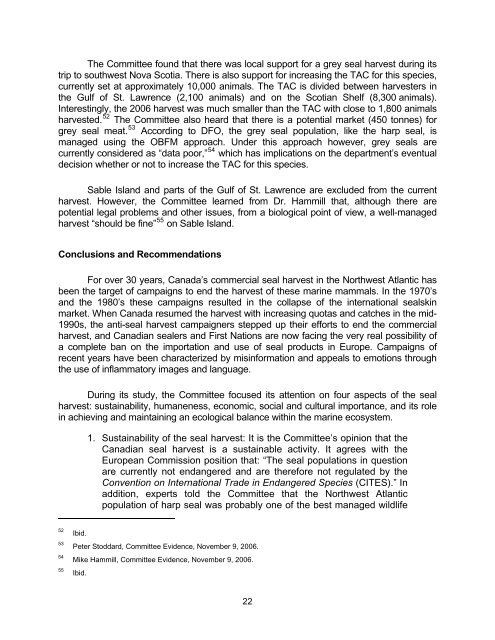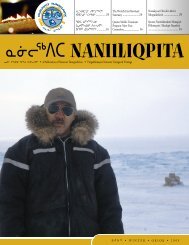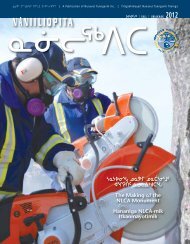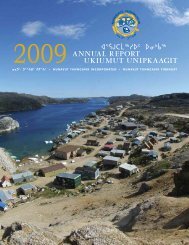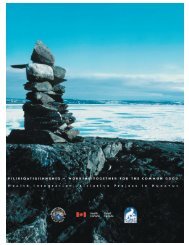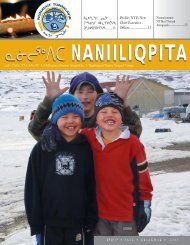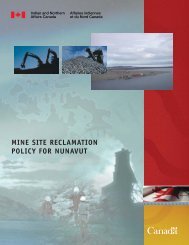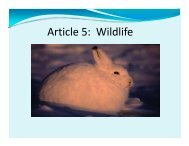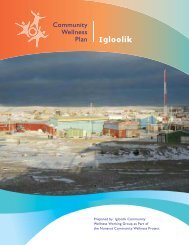Ensuring a Sustainable and Humane Seal Harvest - Nunavut ...
Ensuring a Sustainable and Humane Seal Harvest - Nunavut ...
Ensuring a Sustainable and Humane Seal Harvest - Nunavut ...
Create successful ePaper yourself
Turn your PDF publications into a flip-book with our unique Google optimized e-Paper software.
The Committee found that there was local support for a grey seal harvest during itstrip to southwest Nova Scotia. There is also support for increasing the TAC for this species,currently set at approximately 10,000 animals. The TAC is divided between harvesters inthe Gulf of St. Lawrence (2,100 animals) <strong>and</strong> on the Scotian Shelf (8,300 animals).Interestingly, the 2006 harvest was much smaller than the TAC with close to 1,800 animalsharvested. 52 The Committee also heard that there is a potential market (450 tonnes) forgrey seal meat. 53 According to DFO, the grey seal population, like the harp seal, ismanaged using the OBFM approach. Under this approach however, grey seals arecurrently considered as “data poor,” 54 which has implications on the department’s eventualdecision whether or not to increase the TAC for this species.Sable Isl<strong>and</strong> <strong>and</strong> parts of the Gulf of St. Lawrence are excluded from the currentharvest. However, the Committee learned from Dr. Hammill that, although there arepotential legal problems <strong>and</strong> other issues, from a biological point of view, a well-managedharvest “should be fine” 55 on Sable Isl<strong>and</strong>.Conclusions <strong>and</strong> RecommendationsFor over 30 years, Canada’s commercial seal harvest in the Northwest Atlantic hasbeen the target of campaigns to end the harvest of these marine mammals. In the 1970’s<strong>and</strong> the 1980’s these campaigns resulted in the collapse of the international sealskinmarket. When Canada resumed the harvest with increasing quotas <strong>and</strong> catches in the mid-1990s, the anti-seal harvest campaigners stepped up their efforts to end the commercialharvest, <strong>and</strong> Canadian sealers <strong>and</strong> First Nations are now facing the very real possibility ofa complete ban on the importation <strong>and</strong> use of seal products in Europe. Campaigns ofrecent years have been characterized by misinformation <strong>and</strong> appeals to emotions throughthe use of inflammatory images <strong>and</strong> language.During its study, the Committee focused its attention on four aspects of the sealharvest: sustainability, humaneness, economic, social <strong>and</strong> cultural importance, <strong>and</strong> its rolein achieving <strong>and</strong> maintaining an ecological balance within the marine ecosystem.1. Sustainability of the seal harvest: It is the Committee’s opinion that theCanadian seal harvest is a sustainable activity. It agrees with theEuropean Commission position that: “The seal populations in questionare currently not endangered <strong>and</strong> are therefore not regulated by theConvention on International Trade in Endangered Species (CITES).” Inaddition, experts told the Committee that the Northwest Atlanticpopulation of harp seal was probably one of the best managed wildlife52535455Ibid.Peter Stoddard, Committee Evidence, November 9, 2006.Mike Hammill, Committee Evidence, November 9, 2006.Ibid.22


